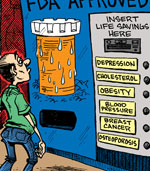Vitamin A Foods - Superior Sources of Vitamin A
| Share on Facebook | Share on Twitter | Share on Google+ |
Vitamin A, also known as retinol, is a substance our bodies make from retinyl palmitate in animal-based vitamin A foods and beta-carotene in plant-based vitamin A foods. Both sources of vitamin A perform equally once the body has transformed them into retinol, but plant sources of the vitamin can be stored much more easily than animal sources.
That's because the retinyl palmitate from vitamin A foods derived from animals have to be stored in the liver, while the beta-carotene from vitamin A foods derived from plants can be stored in our fat cells—and most of have a lot more fat cells than liver cells!
Getting enough vitamin A from food for our day to day needs is a challenge, however, and getting enough vitamin A to correct deficiency is nearly impossible without supplementation. That's because this essential nutrient is not especially abundant even in the best foods with vitamin A.
Retinyl Palmitate in Animal Foods
If you are looking for superior sources of vitamin A, then then hands-down favorite is liver. Specifically, it's the liver of animals that live near the North or South poles.
Before you go looking for penguin livers in the market or getting a permit to hunt walrus, however, you need to know that the livers of most animals that live near the poles contain so much vitamin A that they are actually toxic. An ounce of polar bear liver, for example, can (and has) killed arctic explorers.
But cod liver oil is not so rich in vitamin A that it's toxic. Cod liver oil is by far the best, safe food source of vitamin A. Your own liver can convert 2/3 of a teaspoon (2 ml) of cod liver oil into 3,000 IU of the active form of vitamin A known as retinol.
That's more than is found in nine eggs or half a pound (220 g) of butter, foods which are also relatively good vitamin A sources. Fortunately for our waistlines, our bodies can also use the beta-carotene in certain plant foods.
Beta-Carotene in Plant Foods
The best plant-based food sources of vitamin A are pumpkin and sweet potato. Your body can turn a half-cup (40 g) serving of canned pumpkin or a half-cup (50 g) serving of baked sweet potato into 3,000 IU of vitamin A. That's twice the value of carrots.
Getting the 3,000 IU of A an adult needs every day is easy with cod liver oil, carrots, and sweet potato, but more challenging if you do not eat these foods. Collard greens, kale, and spinach contain about half as much beta-carotene as sweet potato or pumpkin, and about the same amount of beta-carotene as carrots. (You can't see the orange beta-carotene pigment in these vegetables because they contain so much chlorophyll.)
Your body can make the vitamin A it needs from a one-cup (50 g) serving of carrots, collard greens, kale, or spinach every day, but how many of us actually eat these foods every day? Most of us need a vitamin A supplement.
Vitamin A Palmitate to the Rescue
When you can't eat enough foods with vitamin A, taking a daily vitamin A palmitate supplement is an easy, inexpensive, and reliable way to prevent vitamin A deficiency. When it comes to taking vitamin A supplements, more is not necessarily better.
Unless you have a vitamin A deficiency, your liver can only process up to 10,000 IU of vitamin A palmitate in any single day. And even if you do have a vitamin A deficiency, taking as little as 5,000 IU a day will correct it slowly and safely over several months.
Take up to 5,000 IU of vitamin A palmitate every day. If you prefer to take plant-based beta-carotene, then take at least 25,000 IU of mixed tocopherols or beta-carotene in oil. Since body fat absorbs beta-carotene, the more you weigh, the more mixed tocopherols or beta-carotene you need, up to 50,000 IU a day.
Selected References:
Ross AC. Vitamin A and retinoids. In: Shils M, Olson JA, Shike M, Ross AC. ed. Modern Nutrition in Health and Disease. 9th ed. Baltimore: Lippincott Williams & Wilkins; 1999:305-327.
-
Skin CareMen Skin Care
-
Free ResourcesFree eBooks
-
Every person is a God in embryo. Its only desire is to be born.Deepak Chopra
-
Featured Health SupplementTotal Balance
 contains approximately one thousand, two hundred and seventy five times LESS lead than 1 tablet of the Vitamin Shoppe product.
contains approximately one thousand, two hundred and seventy five times LESS lead than 1 tablet of the Vitamin Shoppe product.
-



















